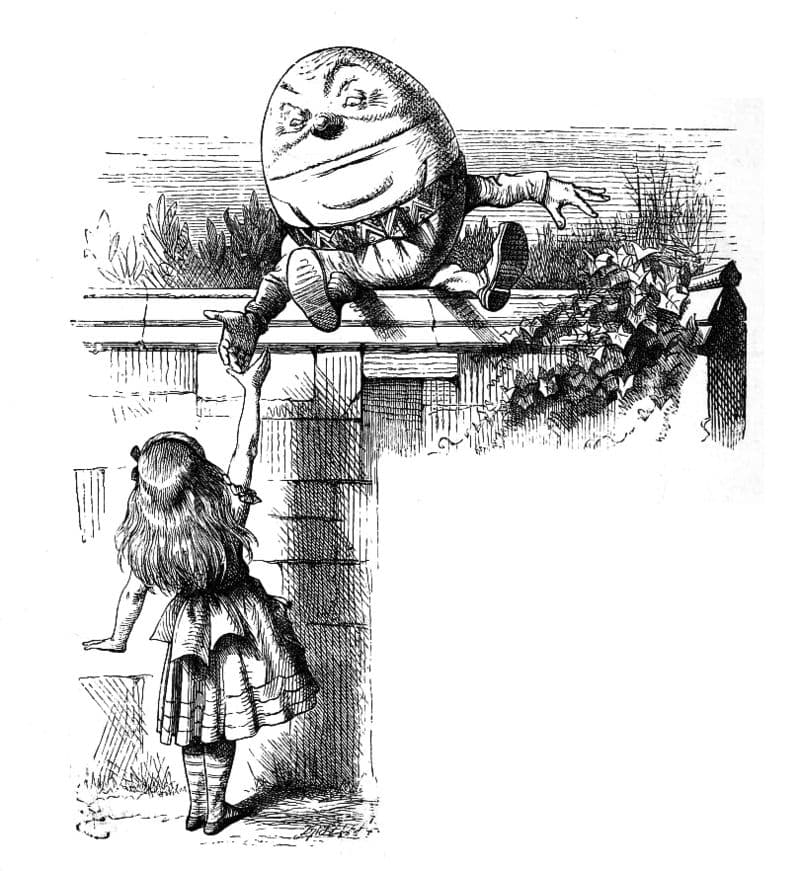‘Humpty Dumpty’ is the perfect name for an egg. There is no doubt in your mind that he is an egg. The zeitgeist has known that he is an egg for generations. That he is never explicitly called an egg is almost irrelevant. At this point, it would be disruptive to interpret him as anything else.
“It’s very provoking,” Humpty Dumpty said after a long silence… “to be called an egg!”
“I said you looked like an egg, sir!” Alice gently explained.
As far as we know, this scene in Lewis Carroll’s Through The Looking Glass and What Alice Found There (1871) is the birth of Humpty Dumpty as we know him. This phenomenon, the Humpty Dumpty treatment, when an adaptation or appropriation becomes definitive, is present throughout literature and pop culture, myths and legends, even religion.
Here are a few key examples:
Dracula: In Bram Stoker’s novel (1897), Jonathan Harker describes the count as a “tall old man, clean-shaven, save for a long white mustache.” He was permanently given the Humpty Dumpty treatment in 1931 when Bela Lugosi’s iconic portrayal was etched into our collective imaginations.
Frankenstein’s Monster: Not to be outdone, Boris Karloff’s zombified, bolt-necked look in 1931’s Frankenstein was all Hollywood, and became the standard, recognizable image of what Mary Shelley created more than a century earlier.
Robin Hood: In 1883, Howard Pyle’s The Merry Adventures of Robin Hood of Great Renown in Nottinghamshire completely shaped the future of the legend, namely his signature look, and the heroic “rob from the rich and give to the poor” motif, which was a far cry from the criminal of the old medieval ballads.
Vikings: The 1800s also gave us the operas of Robert Wagner, in which the common, inaccurate depictions of vikings in horned helmets were introduced. An exciting case of history itself getting Humpty-Dumpty’d.
(Here are a few more fun ones)
White Jesus: While it is difficult to cite and pinpoint the origin of the bearded caucasian man (or baby, for that matter) that is commonly shown to be Jesus of Nazareth, we can safely say that there were white people Humpty Dumptifying Christ through icons and paintings since well before the renaissance.
Lucifer: While Isaiah 14:12 makes mention of Lucifer, the morning star, falling from heaven, nowhere in the bible does it ever say that the devil is a guy named Lucifer, much less a hellbent banished archangel. This interpretation really took shape in John Milton’s epic poem, Paradise Lost (1667).
Ruby Slippers: The iconic, coveted ruby slippers were introduced in 1939’s The WIzard of Oz, probably to take full advantage of the advent of Technicolor, while L. Frank Baum’s original novel (1900), features the much less dazzling-sounding enchanted shoes.
Teenage Mutant Ninja Turtles: And while on the subject of wardrobe, we would be remiss not to mention the TMNT’s identifiable bandannas (blue, red, purple, and orange), made official by the Playmates action figures and classic Saturday morning cartoon. Occasionally, comics artists will still depict the turtles in matching red, as originally designed by Eastman and Laird, but it is generally accepted to have them each in their own colour. In an interview with Cartoonist Kayfabe, Laird stated that, originally, it actually hadn’t occurred to them to differentiate the turtles by their bandannas.
(illustration by John Tenniel, 1871)
